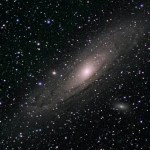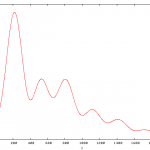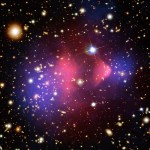Dark Matter
Three awesome things are going on today for you, and I invite you to check them all out:
The latest Carnival of Space is live, where you have your choice of 23 different astronomical topics to choose from. Of course, my post this week on galaxies and how they're made is on there, too!
Pamela L. Gay, cohost of Astronomy Cast, blogger of Star Stryder and all-around great person, saw a press release this week about whether we need dark matter and dark energy. The answer, of course, is yes, but since I'm an expert on that stuff, she came to me and asked me to give my analysis of the…
I've been talking about dark matter a lot, and yet there's still so much to explain about it. For example, dark matter and normal matter (protons, neutrons, and electrons) have a few things in common:
They both have mass.
They both feel the effects of gravity.
They both cause their own gravity.
But that's where the similarities end. I can make a long list of the ways that dark matter and gravity are different from one another, but I prefer to give you an example. Imagine the following scenario: you stand up from your seat, walk towards the wall, and smack right into it. You might wind…
Last week, Jamie (my significant other) came home from work and told me about a conversation she had with her coworker, Chris. This week she asked another one, Miguel, whether he had any questions about Astronomy, Physics, space, etc. This week's question comes from Miguel:
What is a galaxy, anyway? Why does it look like a big bright fuzzy star? And why are there different types of galaxies; shouldn't they all be the same?
This might come as a surprise, but 100 years ago, it was pretty much accepted that we were the only galaxy in the Universe. In fact, there was a great debate in 1920 on…
Last year, I had just finished my Ph.D. studies, and had moved to Madison, WI to teach introductory physics at the University of Wisconsin. I was working on this paper, and when I submitted it, I got a phone call from New Scientist magazine's space division.
Fast-forward two weeks, and I find this article online, where I got to see my name in print:
Now, scientists led by Ethan Siegel of the University of Wisconsin, in Madison, US, have come up with a new way to potentially reveal blobs of dark matter drifting nearby and perhaps even pin down what it is once and for all.
And I thought to…
One of the perks of being a postdoc at a place like the University of Arizona, one of the top places in the US for astronomy, is that we get a number of really interesting visitors. Today we got paid a visit by Tommaso Treu, an astronomer at UC Santa Barbara.
He spoke to us today about one of his most recent, most interesting discoveries, done with the Hubble Space Telescope, of a double Einstein Ring. Take a look at the image below:
You'll notice that there's a ball of light in the center with some ring-like structure(s) around it. These things are rare, first off. There are only two ways…
The first serious advocate of modifying Newton's laws instead of postulating unseen (or dark) matter was Moti Milgrom, from whom today a new article appears on the astrophysics preprint archives.
In particular, Milgrom asserts the following:
MOND predictions imply that baryons alone accurately determine the full field of each and every individual galactic object. These predictions are contrary to the expectations in the DM paradigm in view of the following:
a. the haphazard formation and evolution of galactic objects,
b. the very different influences that baryons and DM are subject to during…
Dave, one of my online chessplaying buddies, asked me this question (edited for appropriateness):
Now this speeding up of the expansion of the universe: Do I understand correctly that one of the theories to explain why relates to "dark matter"?
In real simple terms, what in the dark blue blazes is dark matter, and why and how (and I think the "how" is what keeps you boys up late at night) does it cause this increase in speed?
So Dave gives me the opportunity to, first off, make the distinction between dark matter and dark energy.
Dark matter is, quite simply, matter that doesn't emit…
Taking a look at the background picture, and wondering what it is? It's the Bullet Cluster, also known to astronomers as 1E 0657-56.
What's so special about it? Well, these are actually two galaxy clusters that are in the process of merging, and are colliding with one another! Although this is very cool (and rare) in and of itself, finding this object allowed us to test experimentally the dark matter hypothesis.
If all of the matter in the universe was composed of protons, neutrons, and electrons, then we would find mass in the same place we find light. But look at the x-ray…




